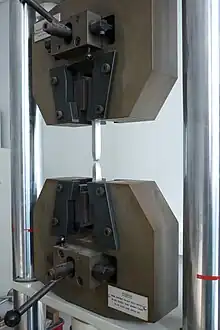Mechanical testing covers a wide range of tests, which can be divided broadly into two types:
- those that aim to determine a material's mechanical properties, independent of geometry.[1]
- those that determine the response of a structure to a given action, e.g. testing of composite beams, aircraft structures to destruction, etc.
Mechanical testing of materials

Tensile test. A standard specimen is subjected to a gradually increasing load (force) until failure occurs. The resultant load-displacement behaviour is used to determine a stress–strain curve, from which a number of mechanical properties can be measured.
There exists a large number of tests, many of which are standardized, to determine the various mechanical properties of materials. In general, such tests set out to obtain geometry-independent properties; i.e. those intrinsic to the bulk material. In practice this is not always feasible, since even in tensile tests, certain properties can be influenced by specimen size and/or geometry. Here is a listing of some of the most common tests:[2]
- Hardness Testing
- Vickers hardness test (HV), which has one of the widest scales
- Brinell hardness test (HB)
- Knoop hardness test (HK), for measurement over small areas
- Janka hardness test, for wood
- Meyer hardness test
- Rockwell hardness test (HR), principally used in the USA
- Shore durometer hardness, used for polymers
- Barcol hardness test, for composite materials
- Tensile testing, used to obtain the stress-strain curve for a material, and from there, properties such as Young modulus, yield (or proof) stress, tensile stress and % elongation to failure.
- Impact testing
- Fracture toughness testing
- Linear-elastic (KIc)
- K–R curve
- Elastic plastic (JIc, CTOD)
- Creep Testing, for the mechanical behaviour of materials at high temperatures (relative to their melting point)
- Fatigue Testing, for the behaviour of materials under cyclic loading
- Load-controlled smooth specimen tests
- Strain-controlled smooth specimen tests
- Fatigue crack growth testing
- Non-Destructive Testing
References
- ↑ Siri, Saeed; Maier, Franz; Chen, Longtu; Santos, Stephany; Pierce, David M.; Feng, Bin (2019). "Differential biomechanical properties of mouse distal colon and rectum innervated by the splanchnic and pelvic afferents". American Journal of Physiology. Gastrointestinal and Liver Physiology. 316 (4): G473–G481. doi:10.1152/ajpgi.00324.2018. PMC 6483024. PMID 30702901.
- ↑ Ed. Gale, W.F.; Totemeier, T.C. (2004), Smithells Metals Reference Book (8th Edition), Elsevier
General references
- Foster, P. Field (2007), The Mechanical Testing of Metals and Alloys, Read Books, ISBN 978-1406734799.
- American Society for Metals (2000), ASM Handbook Volume 8: Mechanical Testing and Evaluation, American Society for Metals, ISBN 978-0871703897.
- Fenner, Arthur J. (1965), Mechanical Testing of Materials (International monographs on materials science and technology), Newnes, ASIN B0000CMMOM.
- Foster, P. Field (2007), The Mechanical Testing of Metals and Alloys, Read Books, ISBN 978-1406734799.
This article is issued from Wikipedia. The text is licensed under Creative Commons - Attribution - Sharealike. Additional terms may apply for the media files.